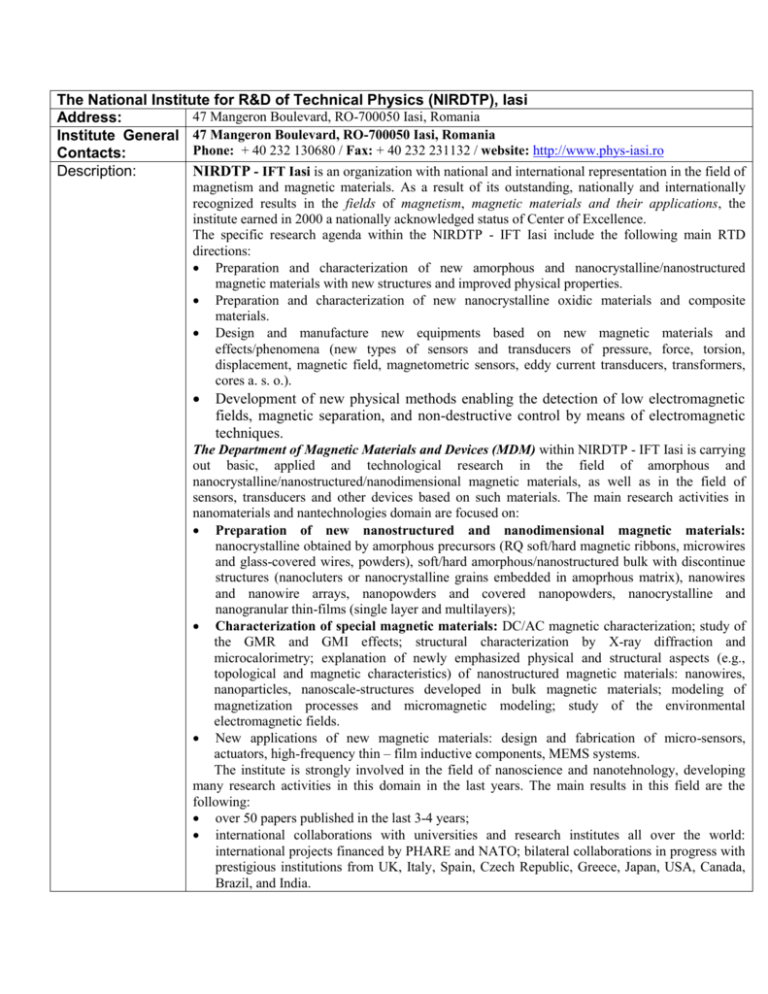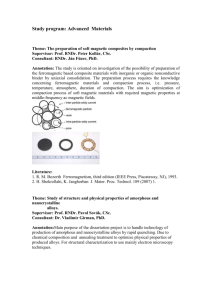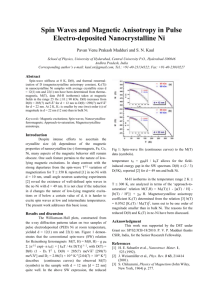National Institute for R&D of Isotopic and Molecular Technologies
advertisement

The National Institute for R&D of Technical Physics (NIRDTP), Iasi 47 Mangeron Boulevard, RO-700050 Iasi, Romania Address: Institute General 47 Mangeron Boulevard, RO-700050 Iasi, Romania Phone: + 40 232 130680 / Fax: + 40 232 231132 / website: http://www.phys-iasi.ro Contacts: Description: NIRDTP - IFT Iasi is an organization with national and international representation in the field of magnetism and magnetic materials. As a result of its outstanding, nationally and internationally recognized results in the fields of magnetism, magnetic materials and their applications, the institute earned in 2000 a nationally acknowledged status of Center of Excellence. The specific research agenda within the NIRDTP - IFT Iasi include the following main RTD directions: Preparation and characterization of new amorphous and nanocrystalline/nanostructured magnetic materials with new structures and improved physical properties. Preparation and characterization of new nanocrystalline oxidic materials and composite materials. Design and manufacture new equipments based on new magnetic materials and effects/phenomena (new types of sensors and transducers of pressure, force, torsion, displacement, magnetic field, magnetometric sensors, eddy current transducers, transformers, cores a. s. o.). Development of new physical methods enabling the detection of low electromagnetic fields, magnetic separation, and non-destructive control by means of electromagnetic techniques. The Department of Magnetic Materials and Devices (MDM) within NIRDTP - IFT Iasi is carrying out basic, applied and technological research in the field of amorphous and nanocrystalline/nanostructured/nanodimensional magnetic materials, as well as in the field of sensors, transducers and other devices based on such materials. The main research activities in nanomaterials and nantechnologies domain are focused on: Preparation of new nanostructured and nanodimensional magnetic materials: nanocrystalline obtained by amorphous precursors (RQ soft/hard magnetic ribbons, microwires and glass-covered wires, powders), soft/hard amorphous/nanostructured bulk with discontinue structures (nanocluters or nanocrystalline grains embedded in amoprhous matrix), nanowires and nanowire arrays, nanopowders and covered nanopowders, nanocrystalline and nanogranular thin-films (single layer and multilayers); Characterization of special magnetic materials: DC/AC magnetic characterization; study of the GMR and GMI effects; structural characterization by X-ray diffraction and microcalorimetry; explanation of newly emphasized physical and structural aspects (e.g., topological and magnetic characteristics) of nanostructured magnetic materials: nanowires, nanoparticles, nanoscale-structures developed in bulk magnetic materials; modeling of magnetization processes and micromagnetic modeling; study of the environmental electromagnetic fields. New applications of new magnetic materials: design and fabrication of micro-sensors, actuators, high-frequency thin – film inductive components, MEMS systems. The institute is strongly involved in the field of nanoscience and nanotehnology, developing many research activities in this domain in the last years. The main results in this field are the following: over 50 papers published in the last 3-4 years; international collaborations with universities and research institutes all over the world: international projects financed by PHARE and NATO; bilateral collaborations in progress with prestigious institutions from UK, Italy, Spain, Czech Republic, Greece, Japan, USA, Canada, Brazil, and India. the delivery of the amorphous and nanocrystalline materials and devices based on them in many countries; Partner in 1 FP 5 European Project (in 2001): “New bulk amorphous materials with soft and hard magnetic properties”, Partners: Studsvik Neutron Research Laboratory, Uppsala University, Suedia – National Institute of Research and Development for Technical Physics – NIRDTP-IFT Iasi, ROMANIA; Partner in 2 FP6 European Projects: 1. A STREP one in Priority 4. Aeronautics and Space – Contract no. AST3-CT-2003-502915, called "Magnetoelastic Energy Systems for Even More Electric Aircraft" – MESEMA 2. A SSA one in Priority 3. Nanotechnologies and Nanosciences – Contract no. INCO-CT-2003510363, called NETWORK FOR NANOSTRUCTURED MATERIALS OF ACC – NENAMAT; Partner in 7 project proposals within the FP 6 (Priority 2 –1; Priority 3 –5; Priority 4 –1); The Department is also involved in a RTN "Marie Curie" - called Magnetic Properties of BMGs, which just passed successfully the first evaluation process. Expertise Experimental facilities Preparation and characterization of amorphous ribbons, wires and glass - covered wires, bulk amorphous and nanocrystalline materials, nanopowders, nanowire arrays, and thin films. Applications of such materials in magnetic sensors and transducers for magnetic field, mechanical force, displacement, pressure, torque, angle, vibrations, presence, and other types, based on the magneto - impedance, Matteucci, Wiedemann effects, magnetostrictive delay line principle, etc. Organisation of scientific conferences: International Workshop ANMM 2001 and 2003 The MDM Department has the necessary equipments for the preparation of materials such as melting apparatus for vacuum and controlled atmosphere, apparatus for the preparation of metallic amorphous ribbons, metallic amorphous wires and glass-covered wires, apparatus for the preparation of nanowire arrays and nanopowders, equipments for the preparation of thin films. There are several installations for thermal, thermo-magnetic, and thermo-mechano-magnetic treatments for samples of different types. The institute has the necessary installations for the characterization of the specific physical properties, such as: vibrating sample magnetometer (VSM), electron scanning microscopy (SEM), atomic force microscope with MFM mode included, fluxmetric set-up for magnetic characterization in AC field at frequencies up to 10 MHz, impedance analyzer from 40 Hz up to 110 MHz, installation for ferromagnetic resonance characterization at frequencies between 1 and 10 GHz. Contact Person & Prof. Dr. Horia CHIRIAC - General Director, hchiriac@phys-iasi.ro E-mail










